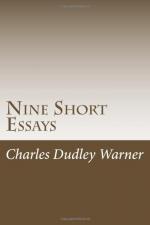The undoubted scene of the loves of Ramona and Alessandro is the Comulos rancho, on the railway from Newhall to Santa Paula, the route that one takes now (unless he wants to have a lifelong remembrance of the ground swells of the Pacific in an uneasy little steamer) to go from Los Angeles to Santa Barbara. It is almost the only one remaining of the old-fashioned Spanish haciendas, where the old administration prevails. The new railway passes it now, and the hospitable owners have been obliged to yield to the public curiosity and provide entertainment for a continual stream of visitors. The place is so perfectly described in “Ramona” that I do not need to draw it over again, and I violate no confidence and only certify to the extraordinary powers of delineation of the novelist, when I say that she only spent a few hours there,—not a quarter of the time we spent in identifying her picture. We knew the situation before the train stopped by the crosses erected on the conspicuous peaks of the serrated ashy—or shall I say purple—hills that enfold the fertile valley. It is a great domain, watered by a swift river, and sheltered by wonderfully picturesque mountains. The house is strictly in the old Spanish style, of one story about a large court, with flowers and a fountain, in which are the most noisy if not musical frogs in the world, and all the interior rooms opening upon a gallery. The real front is towards the garden, and here at the end of the gallery is the elevated room where Father Salvierderra slept when he passed a night at the hacienda,—a pretty room which has a case of Spanish books, mostly religious and legal, and some quaint and cheap holy pictures. We had a letter to Signora Del Valle, the mistress, and were welcomed with a sort of formal extension of hospitality that put us back into the courtly manners of a hundred years ago. The Signora, who is in no sense the original of the mistress whom “H. H.” describes, is a widow now for seven years, and is the vigilant administrator of all her large domain, of the stock, the grazing lands, the vineyard, the sheep ranch, and all the people. Rising very early in the morning, she visits every department, and no detail is too minute to escape her inspection, and no one in the great household but feels her authority.




